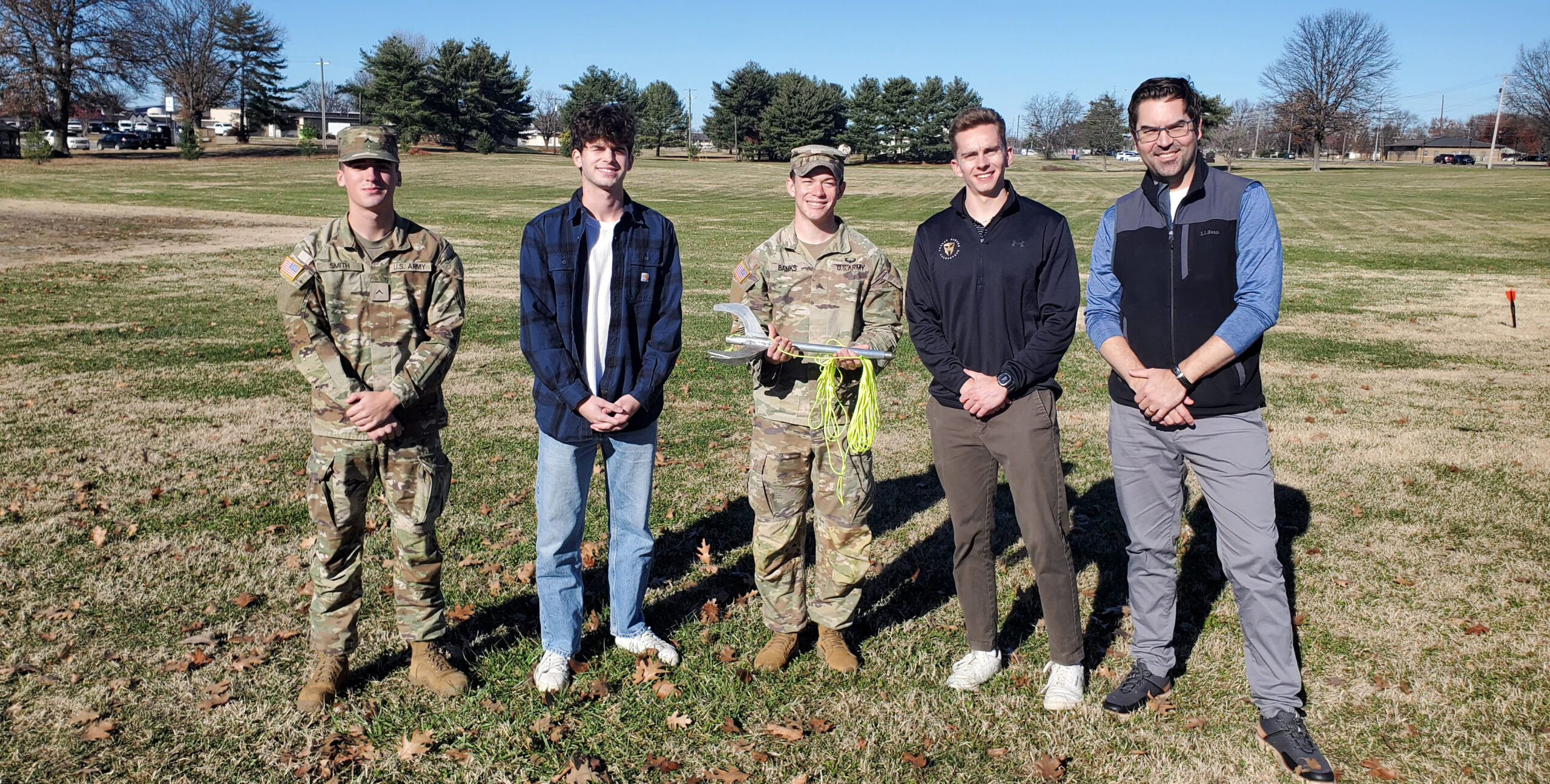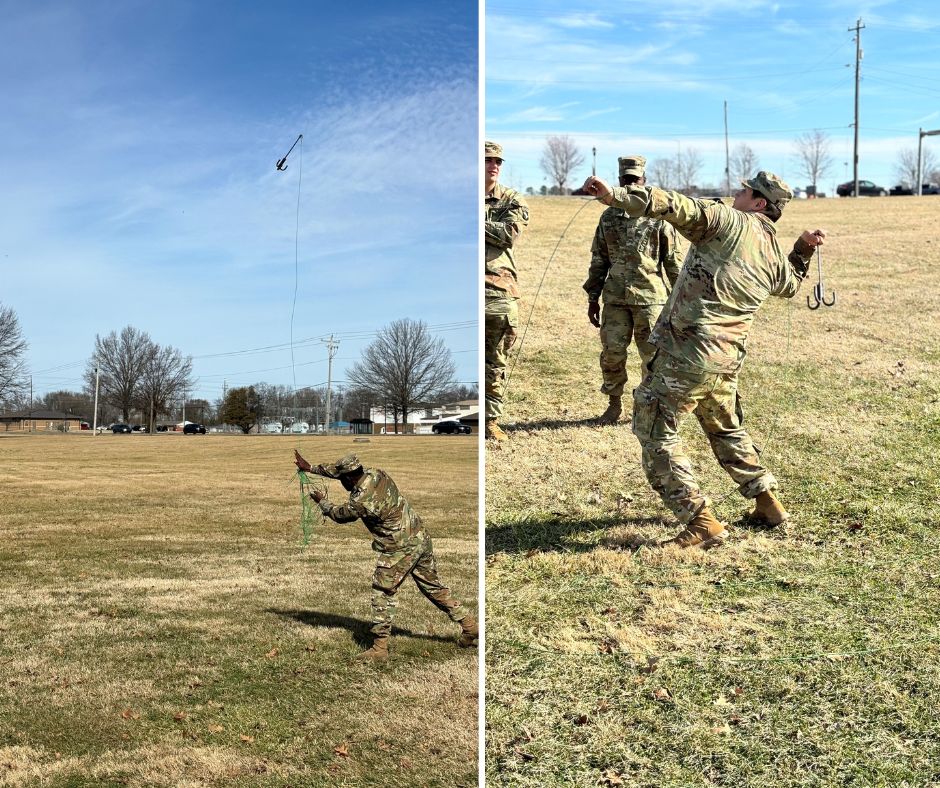This past fall , Vanderbilt students tackled a project to assist combat engineers with safely defusing landmines and other dangerous obstacles, a position for a Soldier that has a survivability rate of less than 10% when in a conflict scenario. The team, composed of 3rd year Jake Schorr, 2nd year Lucas Slater, and 3rd year Gavin Stevens, sought to improve the current grappling hook in use, addressing this critical need in military operations. They worked with Captain Nicholas McDonough, the Fort Campbell Eaglewerx Innovation Officer on the creation of their “Grapneler” for Dr. Kevin Galloway's class, “ME 3273:How to Make Almost Anything, and Make it Matter.”
CPT Nicholas McDonough (1st Brigade Combat Team Innovation Officer, 101st Airborne Division (Air Assault)) explained the importance of the project, stating, “The grapnel hook is a tool that Combat Engineers use for breaching operations. A Soldier in a Sapper squad has the responsibility of using the grapnel to advance on an obstacle, often which is an extremely dangerous job. A Soldier’s ability to accurately throw a grapnel hook in a time sensitive scenario is crucial for both Soldier safety and mission success. Through Vanderbilt’s revamped grapnel design, Soldiers are now provided more control over their grapnel hook throws since the design is not isolated to throwing only underhand.”
Gavin Stevens, who is a Navy ROTC Midshipman, had a personal draw to working specifically on a project that improves Soldier safety. “I wanted to make an impact on the people who I might have the honor of serving with one day,” he said. His team faced several challenges, as they explored concepts ranging from a grappling cannon to a ruggedized fishing pole, , However, the potential difference their solution could make in improving both the effectiveness and survivability of the Soldiers kept them motivated.

Dr. Kevin Galloway, Director of Making at the Wond’ry and Research Associate Professor in Mechanical Engineering at Vanderbilt University commented on the team's dedication, saying “This team experienced the innovation process. Very rarely does an acceptable solution present itself in the first round. It takes iteration and constant feedback from your end user, and this team has learned that if you trust the innovation process, you’ll have a higher probability of converging on a solution that works.”
Dr. Galloway's class provided the team with a comprehensive set of skills, including design drawing, AutoCAD, SolidWorks, laser cutting, 3D printing, molding and casting, composite manufacturing, sewing, electronics, and basic hand tools. This diverse skill set was instrumental in allowing rapid iteration through the design thinking process. The hands-on experience not only enhanced the team's technical abilities but also deepened their understanding of the practical aspects of design and engineering.
Gavin emphasized, "The impact of Dr. Galloway cannot be understated. His technical instruction and mentorship throughout this process were indispensable.The Wond’ry’s resources and the maker tech’s support were also imperative in bridging any technical gaps our team had in prototyping."
The final prototype received optimistic feedback upon testing from the combat engineers at Fort Campbell, which was a rewarding validation of the team's efforts.

SPC David Colas (Bravo Company, 326th Brigade Engineer Battalion, 1st Brigade Combat Team, 101st Airborne Division (Air Assault)) stated, “I love the extension of the grapnel. It provides Soldiers with the ability to throw both overhand and underhand, based on preference. The ability to pick an option for means of throwing that is more efficient and accurate is insurmountable.”
PFC Javier Hernandez (Bravo Company, 326th Brigade Engineer Battalion, 1st Brigade Combat Team, 101st Airborne Division (Air Assault) also commented, “I love the concept of the grapnel created by the Vanderbilt team, a slightly heavier grapnel makes it easier to throw for distance, with less effort. Combat Engineers (12B) benefit greatly from this design/project. Thank you!”
This past spring, the prototype has been refined to a point where Allied Trades can produce the field tested solution and can be introduced into breacher kits going forward.
The project was funded in part by the Soldier-Inspired Innovation Incubator for Discovering Research-Based Solutions Trans-Institutional Programs (TIPs) and by the Design as an Immersive Vanderbilt Experience program through the Office of Experiential Learning and Immersion Vanderbilt.